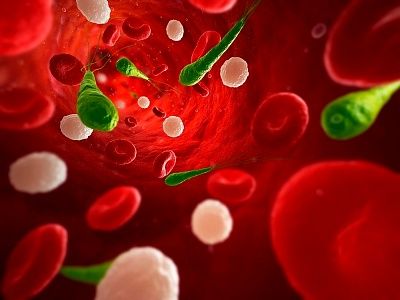
All iLive content is medically reviewed or fact checked to ensure as much factual accuracy as possible.
We have strict sourcing guidelines and only link to reputable media sites, academic research institutions and, whenever possible, medically peer reviewed studies. Note that the numbers in parentheses ([1], [2], etc.) are clickable links to these studies.
If you feel that any of our content is inaccurate, out-of-date, or otherwise questionable, please select it and press Ctrl + Enter.
Blood plasma
Medical expert of the article
Last reviewed: 04.07.2025

Blood plasma is the liquid extracellular part of the bloodstream, making up about 60% of the blood. Its consistency can be transparent or slightly yellowish (due to particles of bile pigment or other organic elements), and blood plasma can also be cloudy as a result of eating fatty foods. Plasma contains protein substances, electrolytes, amino acids, hormones, carbohydrates and lipids, as well as vitamins, enzymes, some gases dissolved in plasma, and products of decay and metabolism of the above-mentioned parts.

The composition can change in the ratio of elements quite often, as it is influenced by many factors, especially the human diet. However, the amount of proteins, cations, glucose is almost constant, as the normal functioning of the blood depends on these elements. Changes in the level of glucose or cations, significantly deviating from the normal limits, can be detrimental not only to human health, but also to his life (for example, dehydration). Frequent and relatively safe changes are subject to quantitative indicators of uric acid, phosphates, neutral lipids.
What is the function of blood plasma?
Blood plasma has a wide range of functions: it transports blood cells, metabolic products and nutrients. Blood plasma binds and controls extravascular fluids (liquid media that work on top of the circulatory system, i.e. intercellular fluid). Through extravascular fluids, blood plasma contacts organ tissues and thus maintains the biological stability of all systems – homeostasis. In addition, blood plasma performs an extremely important function for blood – it maintains balanced pressure (distribution of liquid media in the blood outside and inside the cell membranes). Mineral salts play the main role in ensuring normal osmosis in the body; the pressure level should be within 770 kPa (7.5-8 atm). A small part of the osmotic function is performed by proteins – 1/200 of the entire process. Blood plasma has an osmotic pressure identical to the pressure in blood cells, i.e. it is balanced. For medical purposes, a person may be infused with an isotonic solution that has a pressure similar to that of blood. If it has a lower concentration, it is called hypotonic, it is intended for erythrocytes, for their hemolysis (they swell and disintegrate). If blood plasma loses its liquid component, the salts in it are concentrated, the lack of water is compensated for through the membranes of erythrocytes. Such "salty" mixtures are usually called hypertonic. Both are used as compensation when the blood plasma is insufficient.
Blood plasma: composition, concentration and functional roles of constituent elements
Blood plasma consists of proteins, which are the main part, although they make up only 6-8% of the total mass. Proteins have their own subtypes:
- Albumins are protein substances with low molecular weight, they make up to 5%;
- Globulins are protein substances, large molecular weight, they make up to 3%;
- Fibrinogens are a globular protein and make up to 0.4%.
Functions of plasma protein elements:
- Water balance (homeostasis);
- Maintaining the aggregate state of blood flow;
- Acid-base homeostasis;
- Stability of the immune system;
- Transport of nutrients and other substances;
- Participation in the blood clotting process.
Albumins are synthesized by the liver. Albumins provide nutrition to cells and tissues, regulate oncotic pressure, reserve amino acids and help synthesize proteins, transport bile substances - sterols (cholesterol), pigments (bilirubin), as well as salts - bile acids, heavy metals. Albumins participate in the delivery of medicinal components (sulfonamides, antibiotics).
Globulins are divided into fractions – A-globulins, B-globulins and G-globulins.
- A-globulins activate the production of proteins – components of blood serum (glycoproteins), providing almost 60% of glucose. A-globulins transport hormones, lipids, microelements, and some vitamins. A-globulins are plasminogen, erythropoietin, and prothrombin.
- B-globulins transport bile sterols, phospholipids, steroid hormones, iron, zinc and other metal cations. Beta-globulins include transferrin, which binds iron molecules, deionizes them and distributes them to tissues (to the liver and bone marrow). Hemopexin, which helps bind iron to ferritin, steroid-binding globulin and lipoproteins are also beta-globulins.
- G-globulins have antibodies in their group, which are divided into five classes: IgG, IgA, IgM, IgD, IgE - globulins of the immune system, which protect the body from the invasion of viruses and infections. Gamma globulins are also blood agglutinins, thanks to which blood is determined by groups. G-globulins are synthesized, produced in the spleen, in liver cells, in bone marrow and lymph nodes.
- Fibrinogen is a soluble protein element that allows blood to clot. When fibrinogen combines with thrombin, it is transformed into fibrin, an insoluble form, which is how blood clots are formed. Fibrinogen is produced (synthesized) in the liver.
Any acute inflammatory process can provoke an increase in the amount of plasma proteins, especially active in the inflammation are protease inhibitors (antitrypsins), glycopeptides, and C-reactive proteins. Monitoring the level of C-reactive protein makes it possible to track the dynamics of a person's condition in acute inflammations, for example, in rheumatoid arthritis.
Blood plasma contains organic non-protein substances:
Group I:
These are nitrogen-containing substances:
- 50% of the compounds are urea nitrogen;
- 25% of compounds are amino acid nitrogen;
- Low molecular weight amino acid residues (peptides);
- Creatinine;
- Creatine;
- Bilirubin;
- Indican.
Kidney pathology and extensive burns are often accompanied by azotemia – a high level of nitrogen-containing elements.
Group II:
- These are nitrogen-free substances of organic origin:
- Lipids, carbohydrates, products of their metabolism and breakdown, such as lactate, pyruvic acid (PVA), glucose, ketones, cholesterol.
- Mineral elements of blood.
Inorganic elements contained in blood plasma occupy no more than 1% of the total composition. These are cations Na+, K+, Ca2+, Mg2+ and Cl-, HP042-, HC03-, i.e. anions. Ions contained in plasma maintain the normal state of the body's cells, regulate the acid-base balance (pH).
In medical practice, infusion of physiological media to a patient is used in case of severe blood loss, extensive burns or to support the functioning of organs. These plasma substitutes perform a temporary compensatory function. Thus, an isotonic solution of NaC (0.9%) is equal in osmotic pressure to the pressure in the bloodstream. Ringer's mixture is much more adaptive to blood, since in addition to NaCl it also includes ions - CaCl2+ KCl+, thus, it is both isotonic and ionic in relation to blood. And due to the fact that it includes NaHC03, such a liquid can be considered equal to blood in acid-base balance. Another option - Ringer-Locke mixture is close to the composition of natural plasma due to the fact that it contains glucose. All physiological compensatory fluids are designed to maintain a level of normal, balanced blood pressure in situations associated with bleeding, dehydration, including after surgery.
Blood plasma is an important component of blood, without which the functions of many organs and systems are difficult, and sometimes impossible. This complex biological environment performs many useful functions - ensuring the salt balance necessary for the vital activity of cells, the implementation of transport, protection, excretion and humoral functions.
Использованная литература


 [
[